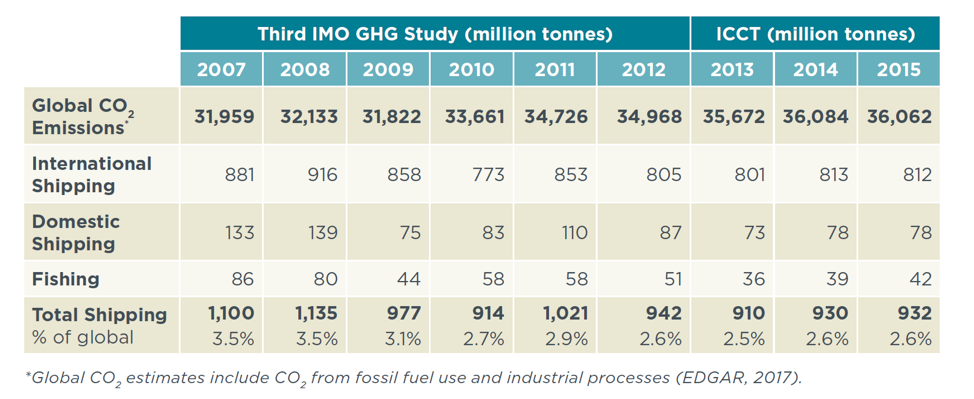Whac-A-Mole on the high seas: The curious case of ship emissions
Blog
Time to party like it's … 2008?
We recently released a comprehensive GHG emission inventory for global shipping, 2013 to 2015. It builds on previous research commissioned by the International Maritime Organization (IMO) that uses global ship positioning data (AIS) to estimate air and climate pollutants from approximately half a million ships operating worldwide. The table below shows our key results. Overall, oceangoing vessels emitted a bit over 800 million metric tonnes (MMT) of carbon dioxide (CO2) in 2015. That means that if it were ranked alongside nations in terms of total CO2 emissions, international shipping would be sixth, with about 4% more than Germany’s 778 MMT. Emissions from global shipping increased 2.4% over the period studied, reversing the overall trend of falling emissions in place since the global financial crisis of 2008–2009.

Our colleagues at the International Chamber of Shipping (ICS) have referenced the study as a good news story, noting that shipping emissions remain below their 2008 peak. All good, nothing to see here, IMO’s got this. We think that’s an overly rosy view of the data.
Two factors complicate the comparison of 2015 and 2008 emissions. First, while we remained mostly faithful to IMO’s methodologies, we did make minor adjustments in how we estimated fuel efficiency penalties attributable to two factors: hull fouling and weather. The former in particular may lead to a somewhat lower estimate of emissions compared to IMO’s third GHG study. Second, satellite coverage of AIS signals has been continuously improving over time, reducing the uncertainties associated with the analysis. Over just the three years studied, we saw the hourly coverage of AIS data improve from 41% to 53%, which reduces the need for data processing to fill in the blanks. This may explain why our estimate is converging with “top down” marine fuel consumption estimates derived from international bunker fuel sales data. Poorer satellite coverage may also explain why modeled emissions before 2012 were so volatile. For these reasons, direct comparisons of our 2015 results to IMO’s estimate for 2008 should be made carefully.
There’s another reason to be less sanguine than ICS: namely, ship emissions are very sensitive to speed, such that even small changes could fuel a big bounce back in emissions. Consider this quick back-of-the-envelope calculation. Our study found that between 2013 and 2015 transport supply – expressed as deadweight tonne nautical miles, or dwt-nm – increased by 7%. Most of the increased supply was provided by lengthening the operational hours of existing ships, from a total of 1.3 million to 1.5 million hours per year for the largest container ships, for example. Assume that, similarly, transport supply has increased by an additional 7% since 2015, not from further increasing operational hours but rather from increasing cruise speeds. Ballpark, a 7% increase in cruise speeds would increase overall fuel consumption for international shipping by 13% after accounting for differing engine loads and auxiliary and boiler fuel use. This would put international shipping CO2 emissions at about 918 MMT, or right back at IMO’s 2008 maximum, as you can see in the table above.
This is just a simple calculation, but it highlights the risk of being complacent about recent emission trends. There isn’t much evidence that slow-steaming practices unwound industrywide as of 2015. Still, there’s reason to be concerned. As we’ve shown, the operating speeds of large tankers and container ships increased by 4% and 11%, respectively, from 2013 to 2015. If other ship types follow suit, it wouldn’t take much for shipping emissions to chart new highs.
This is the challenge of “latent emissions” caused by continued growth in shipping supply first identified by IMO in 2014. Instead of partying like it’s 2008, IMO should take a hard look at speed management policies when it meets to discuss a shipping climate target next week in London.
